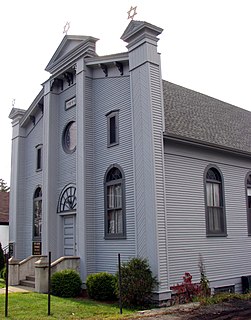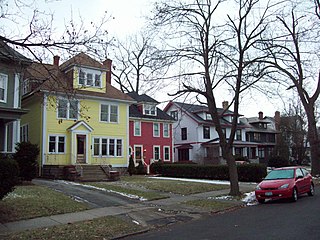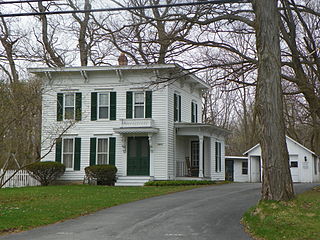Henry Wright (1878-1936), was a planner, architect, and major proponent of the garden city, an idea characterized by green belts and created by Sir Ebenezer Howard.

The George W. Smith House is a home in the Chicago suburb of Oak Park, Illinois, United States designed by American architect Frank Lloyd Wright in 1895. It was constructed in 1898 and occupied by a Marshall Field & Company salesman. The design elements were employed a decade later when Wright designed the Unity Temple in Oak Park. The house is listed as a contributing property to the Ridgeland-Oak Park Historic District which joined the National Register of Historic Places in December 1983.

The Thomas H. Gale House, or simply Thomas Gale House, is a house located in the Chicago suburb of Oak Park, Illinois, United States. The house was designed by famous American architect Frank Lloyd Wright in 1892 and is an example of his early work. The house was designed by Wright independently while he was still employed in the architecture firm of Adler & Sullivan, run by engineer Dankmar Adler and architect, Louis Sullivan; taking outside commissions was something that Sullivan forbade. The house is significant because of what it shows about Wright's early development period. The Parker House is listed as contributing property to a U.S. federally Registered Historic District. The house was designated an Oak Park Landmark in 2002.

The Charles E. Roberts Stable is a renovated former barn in the Chicago suburb of Oak Park, Illinois, United States. The building has a long history of remodeling work including an 1896 transformation by famous American architect Frank Lloyd Wright. The stable remodel was commissioned by Charles E. Roberts, a patron of Wright's work, the same year Wright worked on an interior remodel of Roberts' House. The building was eventually converted into a residence by Charles E. White, Jr., a Wright-associated architect, sources vary as to when this occurred but the house was moved from its original location to its present site in 1929. The home is cast in the Tudor Revival style but still displays the architectural thumbprint of Wright's later work. The building is listed as a contributing property to a federally designated U.S. Registered Historic District.

The George T. Wisner House, also known as Oak Hill, is a historic home located on South Street in Goshen, New York, United States. It was built about 1840, and is a Greek Revival style frame dwelling that incorporates an earlier Federal style dwelling built about 1805. It has a broad gabled roof and a central hall plan interior. The front section is 2 1/2-stories, five bays wide and four bays deep.

The Historic Beth Joseph Tupper Lake Synagogue and Gallery is a historic synagogue located in Tupper Lake, Franklin County, New York. It was built in 1906, and is a 2 1⁄2-story, three-bay by five-bay, vernacular Italianate style frame building. It is sheathed in clapboard and has a false front that hides a steep gable roof. The front facade features a "sun dial" arch and rose window, round arched windows, and square corner towers. Also on the property is a contributing 2 1⁄2-story, hip-roofed frame dwelling built between 1906 and 1910. The synagogue was closed for over three decades. Today, it is the oldest synagogue in the Adirondack Mountains, but it is only open in the summer. It houses a small museum.

The Zimmerman House is a historic house located at 223 Heather Street in Manchester, New Hampshire. Built in 1951, it is the first of two houses in New Hampshire designed by Frank Lloyd Wright, and one of a modest number of Wright designs in the northeastern United States. The house was built for Dr. Isadore Zimmerman and his wife Lucille. The house is now owned by the Currier Museum of Art because of the Zimmermans' decision to donate the home to the public after their death. The museum provides tours of the building, which is the only legal access to the grounds. It was listed on the National Register of Historic Places in 1979.

The Douglas and Charlotte Grant House is a historic building located in Marion, Iowa, United States. Located on 40 acres (16 ha) of land, this Frank Lloyd Wright designed Usonian-style dwelling was constructed from 1949 to 1951, with some construction continuing to about 1960. This is one of the first houses in Iowa built in this style, having been completed a year after the Lowell E. Walter House located near Quasqueton. The two houses are very similar in style. The characteristics that mark this as a Wright-designed house include: the house integrated into the site and opened to the outdoors; the use of window walls and horizontal bands of windows; natural lighting and ventilation; use of natural materials; a horizontal emphasis in mass and proportion; a car port in place of a garage; slab-on-grade construction with radiant heat system embedded in the slab; a flat roof; an open-plan interior; varied ceiling heights on the interior; built-in furniture; and a large scale fireplace with a central hearth. The limestone for the house was quarried on the property. The house was listed on the National Register of Historic Places in 1988.

Parkside East Historic District is a national historic district located at Buffalo in Erie County, New York. The district is architecturally and historically significant for its association with the 1876 Parks and Parkways Plan for the city of Buffalo developed by Frederick Law Olmsted. It consists of 1,769 contributing structures developed from 1876 to 1936, as a middle class residential neighborhood. The district largely contains single-family dwellings, built in a variety of popular architectural styles, and located along the irregular and curvilinear street pattern developed by Olmsted. The district is located to the east of Buffalo's Delaware Park and includes the Walter V. Davidson House and the separately listed Darwin D. Martin House, both designed by Frank Lloyd Wright.

Reuben Wright House is a historic home located at Westfield in Chautauqua County, New York. It is a two-story, eight bay structure built primarily of brick. The earliest portion of the dwelling was apparently built in the early 1830s and it is one of the earliest extant structures in the area. For some time in the mid-19th century the dwelling operated as a tavern and known as the Drovers Inn.

Asahel Warner House is a historic home located at Lima in Livingston County, New York. It was built about 1810 and is a large two story, three bay, rectangular frame dwelling with its gable end oriented toward the street. A one-story kitchen wing is located at the rear. It was remodeled in the 1860s / 1870s and in 1907 and features Italianate details. A third floor attic contains a Masonic Lodge meeting room with paneling dated to 1907. It is set into the eaves of the front two thirds of the building and lit only by the front oculus window. Also on the property are a contributing barn, shed, and chicken coop.

Bristol House is a historic home located at Lima in Livingston County, New York. It was built between 1870 and 1875 and is a two-story, three bay wide by two bay deep, Italianate style frame dwelling. The front facade is dominated by the elaborate canopy above the slightly recessed, paneled wooden doors of the side hall entrance.

William DePuy House is a historic home located at Lima in Livingston County, New York. It was built about 1851 and is a 1 1⁄2-story frame dwelling with vernacular Greek Revival and Gothic Revival design elements. The front features a 1-story hip-roofed porch supported by Doric columns.

The Architecture of Buffalo, New York, particularly the buildings constructed between the American Civil War and the Great Depression, is said to have created a new, distinctly American form of architecture and to have influenced design throughout the world.

The Slaughter–Hill Ranch, in Roswell, New Mexico, also known as Cunningham Homestead, Estancia Pavo Real, or the Canning Farm, was listed on the National Register of Historic Places in 1988.

Wright House is a historic home located at Newark, New Castle County, Delaware. It was built in 1922 and is a 2 1⁄2-story "E"-shaped brick dwelling with a five-bay front facade. It is in the Colonial Revival style. It features a three bay main portico with fluted Corinthian order columns and a frame porte cochere. The house was purchased by the University of Delaware after 1950 and serves as the home of the University President.

Bell-Sherrod House is a historic home located at Enfield, Halifax County, North Carolina. It was built about 1859, and is a two-story, rectangular, Italianate-style frame dwelling, with a Greek Revival-style front porch. It has a shingled hip roof pierced by two interior chimneys and is sheathed in weatherboard. A conservatory was added about 1915. The house was restored about 1987.

Hoffman-Bowers-Josey-Riddick House is a historic home located at Scotland Neck, Halifax County, North Carolina. It was built in 1883, and is a 2 1/2-story, rectangular, frame dwelling with Stick Style / Eastlake Movement design elements. It has a complex polychromed, slate roof gable roof; three-story central tower with hexagonal roof; and one-story rear ell. It features a front porch with sawn balustrade.

Stewart-Hawley-Malloy House is a historic home located near Laurinburg, Scotland County, North Carolina. It was built about 1800, and is a transitional Georgian / Federal style frame dwelling. It consists of a two-story, five bay by two bay, main block with a one-story, two bay by four bay, wing. The main block has a full-width, one-story front porch and rear shed additions. It was built by North Carolina politician James Stewart (1775-1821) and the birthplace of Connecticut politician Joseph Roswell Hawley (1826-1905).

The Flying H Ranch, near Roswell, New Mexico, was listed on the National Register of Historic Places in 1988. The listing included 10 contributing buildings on four discontinuous areas.




















